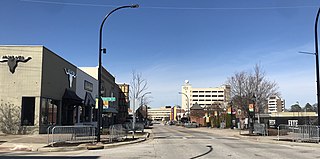
Decatur is the largest city and county seat of Morgan County in the U.S. state of Alabama. Nicknamed "The River City," it is located in northern Alabama on the banks of Wheeler Lake along the Tennessee River. The population was 57,938 at the 2020 census.

Cahaba, also spelled Cahawba, was the first permanent state capital of Alabama from 1820 to 1825. It was the county seat of Dallas County, Alabama until 1866. Located at the confluence of the Alabama and Cahaba rivers, the town endured regular seasonal flooding.

The Alabama State Capitol, listed on the National Register of Historic Places as the First Confederate Capitol, is the state capitol building for Alabama. Located on Capitol Hill, originally Goat Hill, in Montgomery, it was declared a National Historic Landmark on December 19, 1960. Unlike every other state capitol, the Alabama Legislature does not meet there, but at the Alabama State House. The Capitol has the governor's office and otherwise functions as a museum.
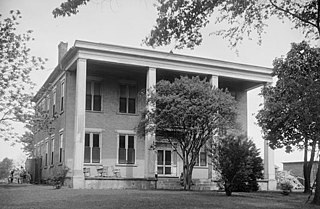
The Rhea–McEntire House, also known as the Rhea–Burleson–McEntire House, is a historic antebellum Greek Revival mansion located along the shoreline of the Tennessee River's Wheeler Lake in Decatur, Alabama.

The Rosenbaum House is a single-family house designed by architect Frank Lloyd Wright and built for Stanley and Mildred Rosenbaum in Florence, Alabama. A noted example of his Usonian house concept, it is the only Wright building in Alabama, and is one of only 26 pre-World War II Usonian houses. Wright scholar John Sergeant called it "the purest example of the Usonian."
The Seth Lore and Irwinton Historic District is a historic district in Eufaula, Barbour County, Alabama. It was listed on the National Register of Historic Places in 1973 as Lore Historic District; the registration document identified and described 72 specific buildings. And then its boundaries were increased and the district was renamed to "Seth Lore and Irwinton Historic District" in 1986; the entire area then contained 738 contributing buildings.
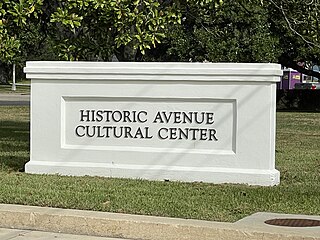
The architecturally and historically significant Historic Avenue Cultural Center is an exhibit and event space that serves as an anchor to Mobile, Alabama’s budding Civil Rights and Cultural Heritage District. From the early 1990s to approximately 2015, it served as the National African American Archives and Museum. Formerly known as the Davis Avenue Branch of Mobile Public Library, it was the lone Black library in Mobile County during segregation.

St. John's Episcopal Church is a historic Gothic Revival church in Montgomery, Alabama, United States. It was designed by the New York City architectural firm of Frank Wills and Henry Dudley. The church was placed on the National Register of Historic Places on 24 February 1975.
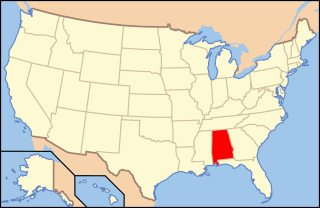
The following is an alphabetical list of articles related to the U.S. state of Alabama.

Albany, Alabama, also known as New Decatur, Alabama, was a city in Morgan County, Alabama, United States, situated immediately to the southeast of the city of Decatur near the Tennessee River. New Decatur/Albany existed as a city from 1887 until 1927, when it merged with the city of Decatur. Today, it exists as a neighborhood within the city of Decatur, and is on the National Register of Historic Places.

Everhope, known throughout most of its history as the Captain Nathan Carpenter House and more recently as Twin Oaks Plantation, is a historic plantation house near Eutaw, Alabama. Completed in 1853 for Nathan Mullin Carpenter, it is listed on the National Register of Historic Places and Alabama Register of Landmarks and Heritage due to its architectural and historical significance.
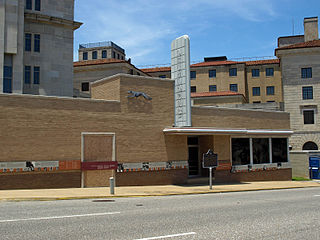
The Freedom Rides Museum is located at 210 South Court Street in Montgomery, Alabama, in the building which was until 1995 the Montgomery Greyhound Bus Station. It was the site of a violent attack on participants in the 1961 Freedom Ride during the Civil Rights Movement. The May 1961 assaults, carried out by a mob of white protesters who confronted the civil rights activists, "shocked the nation and led the Kennedy Administration to side with civil rights protesters for the first time."

Sturdivant Hall, also known as the Watts-Parkman-Gillman House, is a historic Greek Revival mansion and house museum in Selma, Alabama, United States. Completed in 1856, it was designed by Thomas Helm Lee for Colonel Edward T. Watts. It was added to the National Register of Historic Places on January 18, 1973, due to its architectural significance. Edward Vason Jones, known for his architectural work on the interiors at the White House during the 1960s and 70s, called it one of the finest Greek Revival antebellum mansions in the Southeast.

The John Tyler Morgan House is a historic Greek Revival-style house in Selma, Alabama, United States. It was built by Thomas R. Wetmore in 1859 and sold to John Tyler Morgan in 1865. Morgan was an attorney and former Confederate general. Beginning in 1876, he was elected as a Democratic U.S. senator from Alabama for six terms. He used this house as his primary residence for many of those years.

Stephen Decatur Button was an American architect and a pioneer in the use of metal-frame construction for masonry buildings. He designed commercial buildings, schools and churches in Philadelphia, Pennsylvania, and Camden, New Jersey; and more than 30 buildings in Cape May, New Jersey.

The Bemidji Carnegie Library is a former library building in Bemidji, Minnesota, United States. It was built as a Carnegie library in 1909 and housed the city's public library until 1961. It was listed on the National Register of Historic Places in 1980 for its local significance in the themes of architecture and education. It was nominated for being a well-preserved example of a Carnegie library and of public Neoclassical architecture.

The First National Bank is a historic bank building in Huntsville, Alabama. The temple-form Greek Revival structure was built in 1835–1836. Designed by locally famous architect George Steele, it occupies a prominent position, facing the courthouse square and sitting on a bluff directly above the Big Spring. It was the longest-serving bank building in Alabama, operating until 2010 when Regions Bank moved their downtown branch to a new location. The building was listed on the National Register of Historic Places in 1974.

The Bank Street–Old Decatur Historic District is a historic district in Decatur, Alabama. The district encompasses the original commercial and residential portion of Decatur along the Tennessee River. In 1832, Decatur was selected over the larger Huntsville as the site of the northern branch of the state bank. Bank Street became the commercial hub of the town, as it was the only place in the Tennessee Valley were riverboat, wagon, and rail transportation converged. Due to its strategic location, the town suffered heavy damage in the Civil War; the Todd House on Lafayette Street is one of only four buildings in Decatur to survive the war. As the town was rebuilding from the war, a fire in 1877 destroyed most of the buildings along Bank Street. The rebuilt structures were all of brick, and represent Italianate, Victorian, and Commercial styles popular from the late 19th to the early 20th centuries. Houses in the district are primarily modest, and styles include vernacular Victorian, Shingle-style, and Craftsman bungalows.

The Dancy–Polk House is a historic residence in Decatur, Alabama. The house was built in 1829 for Colonel William Francis Dancy, an early settler in the area, who later moved to Franklin, LA. It is the oldest building in Decatur, and one of only four to survive the Civil War. Dancy came to North Alabama from southern Virginia, and built a Georgian house popular in his homeland. The two-story frame house has a double-height portico with four Doric columns on each level. The house was listed on the Alabama Register of Landmarks and Heritage in 1978 and the National Register of Historic Places in 1980.
The Columbus Register of Historic Properties is a register for historic buildings and other sites in Columbus, Ohio, United States. The register is maintained by the City of Columbus Historic Resources Commission and Historic Preservation Office, and was established in 1980. Many of these landmarks are also listed on the National Register of Historic Places, providing federal tax support for preservation, and some are further designated National Historic Landmarks, providing additional federal oversight.



















